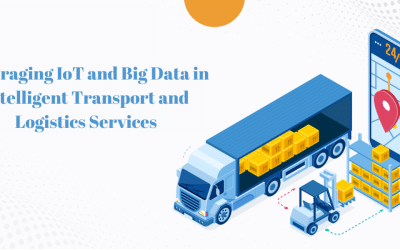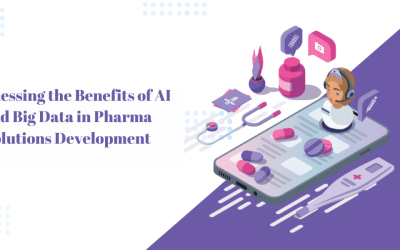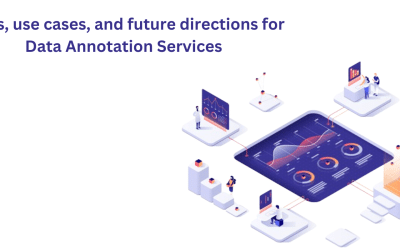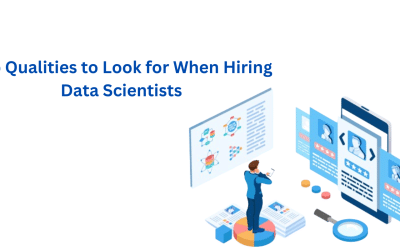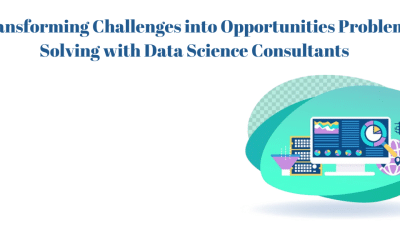Data is growing staggeringly in the fast-paced world of technology, ranging from 2.5 million bytes daily. However, it requires an organization to make sense. With ever-growing customer expectations, new pressures from competitors, and an uncertain outlook for the economy, executives need their data to provide more excellent value than ever before. What can you do to get the most value out of the data you collect? Using big analytical tools for data can allow all employees in your company to get meaningful insight through the endless stream of data.
Big Data is currently one of the top niches for creating and enhancing enterprise software. The growing demand for big data technologies is a result of the increase in the volume of fast data. Companies must gain valuable insight from the vast ocean of data with the help of a Big Data Consulting Company, which provides proper tools to analyze data and skilled data analysts. By transforming information into functional patterns, businesses can improve their methods and stay ahead of the curve.
Handling big data has become a crucial skill for businesses and data researchers. Big data’s characteristics are volume, speed, and range, giving unrivaled insight into trends and patterns. Special tools are required for the successful handling of such data.
In this blog post, we’ll explore the best methods and tools for big data.
What Exactly Is Big Data Technology, And How Does It Functions?
The expression “big data technology” describes the applications that use software to handle various types of data and turn them into useful information that companies can use. This technique takes a considerable volume of data with complex patterns and utilizes it to analyze, understand the information, and then extract it into proper form. The newest and fastest-growing technologies, like artificial intelligence, the Internet of Things, and machine learning, are closely entwined with big data technology.
Big data may be classified as structured or unstructured. Structured data comprises information already organized using spreadsheets or databases and is usually numerical in nature. Unstructured data refers to information that’s not arranged and doesn’t conform to an established format or model. This includes information gathered from sources such as social media and helps institutions collect details about their customers’ requirements.
The vast majority of data is gathered by analyzing comments posted on social media and websites and through personal devices and apps through questionnaires, purchases, and online check-ins. Sensors and other smartphone sensors allow data to be collected over the entire spectrum of scenarios and situations. Most big data is stored in database systems and analyzed with programs specifically developed for massive, complicated datasets. Many software-as-a-service (SaaS) companies specialize in managing this type of complex data.
The Benefits Of Big Data
Processing more significant amounts of data quicker can bring enormous benefits to an organization, allowing it to use data to solve crucial queries efficiently. Analytics based on big data is vital as it will enable organizations to use massive quantities of data in various formats and sources to spot opportunities and threats. Big Data Consulting Services helps organizations make quick decisions, fully utilize big data, and boost their bottom line. A few advantages of big data analytics are:
Cost Diminution
Big data could cut costs by storing all the company’s information in one location. Analytics tracking can help companies discover ways to operate better and save money whenever possible.
Product Development
Developing and promoting new services, products, or brand names is a lot easier with data gathered from customers’ needs. Big data analytics can help firms understand their product’s viability and stay on top of developments.
Decisions For Business That Make Sense
Continuously analyzing data can help businesses make better and more efficient decisions, such as optimizing supply chains and costs.
Customer Experience
The use of data-driven algorithms can help marketers (targeted ads, for instance) and improve the satisfaction of customers by providing a more pleasant user experience.
Risk Management
Business owners can detect risk by studying data patterns and devising strategies to manage it.
What Are The Key Features To Look For In Big Data Tools?
Big data analytics tools help us understand all the information we’re absorbing and make better decisions based on it. We’ll look at what’s available in a major data analytics tool prior to deciding on the best one.
Manages Large Amounts Of Data
The name suggests that dealing with huge volumes of data is the primary requirement for large-scale analytics software. This is because you require a scalable big data analytics tool that can process your company’s present and future volumes of data in real-time. Furthermore, the system must be able to connect with several clouds and databases. This allows you to analyze the unused data stored in your data warehouses and discover potential growth areas that could be clearer.
Interactive Data Visualization
Spreadsheets can be tedious and challenging to read. Making complex data into visualizations allows you to present information in an easy-to-read context and actionable ways. While you evaluate the right solutions, be sure the significant data analytics software offers a user-friendly and straightforward user interface. It lets users personalize their dashboards and make interactive visualizations of data so that everybody can get the data they need and take timely action.
Innovative AI Capabilities
The tools to analyze big data can be used for more than just performing ad-hoc queries or creating visualizations. The latest solutions provide advanced AI tools, such as conversation AI or natural language search. It can help individuals and teams dig into the nuggets of data to uncover valuable insight.
However, the data team can use the power of conversation AI for deeper analysis of their data by asking questions and following up on inquiries, just like conversing with a colleague via Slack. This can significantly reduce the time to insight and encourage timely and informed decisions throughout the company.
Does It Have Real-World Applications?
What are the best ways to tell the effectiveness of a product in real life? The only way to determine this is by putting it on the line. To determine the credibility of a provider and show the ability of their solution to tackle complex business issues, review customer cases and reviews to get the most current information on the system’s features, capabilities, and customer service. Also, we recommend examining the platform prior to attempting demos, as this will help you understand what the platform can do.
Offers Self-Service Analytics
Big data analytics software should provide self-service analytics instead of gatekeeping information for a small group of IT experts and analysts. By democratizing data and permitting any business person to access the information they need on their own, each decision-maker can discover the information they require whenever they require it. Self-service analytics allow users to create comprehensive reports and live dashboards and monitor company performance from anywhere, making data-driven choices instead of relying on instincts.
Top Big Data Techniques
Each characteristic influences the techniques and tools used to deal with massive data. We employ big data techniques, algorithms, and strategies to analyze, process, and deal with massive data. At first glance, they’re identical to those used in standard data. However, the large data particularities we discussed require various approaches and techniques.
These are the most popular tools and methods in the Big Data domain.
Big Data Processing
Data processing refers to the operations and actions that transform unstructured data into valuable data. It involves everything from cleaning and structuring data to executing complex algorithms and data analytics. Sometimes, big data is processed in batches; however, streaming data is more common.
Features
- Spreading tasks over several servers or nodes to handle data simultaneously and speed up computation processing.
- Data processing can occur in real-time (as it’s created) or batch (processing portions of data at timed intervals).
- Big Data tools manage massive datasets by scaling up by adding resources or nodes.
- If the node is not functioning, it will resume processing to ensure the data’s integrity and accessibility.
- Big data can be derived from numerous sources. It could be logs, structured databases, streams, or other unstructured data repositories.
Big Data Storage
Big data storage must hold massive amounts of data generated at high speeds and in a variety of formats. Three of the most effective ways to manage big data include NoSQL databases, data lakes, and data warehouses. NoSQL databases are designed to manage large quantities of data, both structured and unstructured, with no fixed schema (NoSQL—not Only SQL). They can adapt to changes in the structure of data.
Contrary to conventional, vertically scalable database systems, NoSQL databases can be horizontally adaptable, which means they can transfer data over many servers. It is easier to scale by adding additional machines. They’re fault-tolerant, low-latency (appreciated when applications require instantaneous data access), and cost-efficient in scale.
They are centers that store vast amounts of data in raw native format. It makes data and analyses more accessible because all information is in one spot. Data lakes can be scalable and economical. They are flexible (data is taken in raw form, and a structure is established by reading data to analyze it). They support batch and real-time data processing. They also can be integrated with software for data quality, leading to advanced data analytics and deeper insight.
A data warehouse is a central repository designed for analysis processing. Information gathered from multiple sources is stored and translated to an easily analyzed and reported format for analysis and reporting purposes. It’s built to house massive amounts of information, integrate it with other sources, and facilitate the study of historical data since it is stored in a way that has a duration dimension.
Features
- The design was designed to be scalable by adding more Nodes or Units.
- The data is usually stored on many servers or nodes, which provides high reliability and fault tolerance.
- The system can process structured, semi-structured, and unstructured information.
- When data is saved, it remains in place and accessible, even during the possibility of hardware malfunctions.
- Most big data storage systems are built to work on common hardware, which lowers their cost at scale.
Big Data ETL
ETL is the process of extracting information from different sources, transforming it into a structured, suitable format, and then loading it onto a storage system to be used for research or other reasons. Large data features mean the ETL process has to manage more information from a variety of sources. Most data is semi-structured or unstructured. It transforms and is stored differently from structured data. ETL with big data typically requires processing data in real-time.
Features
- The data is pulled from various sources, such as logs, databases, APIs, and flat file formats.
- The extracted data is converted to a format suitable for analysis, querying, or reporting. This involves cleansing and enriching the data, aggregating, and reformatting the information.
- The transformed data is stored in the target system, e.g., a data warehouse, data lake, or database.
- Real-time ETL techniques are more common in large datasets than batch processing.
- ETL incorporates data from various sources, providing a complete perspective of all data in an entire organization.
Big Data Mining
It’s about identifying patterns, relationships, anomalies, and statistical connections in massive databases. It requires disciplines such as statistics and machine learning, as well as using databases to discover insights into information. The quantity of data analyzed is enormous, and the volume will reveal patterns that would not be evident even in smaller data sets. The bulk of data is sourced from multiple sources and is usually non-structured or semi-structured. It requires more advanced processing and integration methods. Contrary to standard data, big data are typically processed in real-time.
Software used in large-scale data mining must manage all of these. For this, it is necessary to use computer systems that are distributed, i.e., the data processing takes place across several computers. Some algorithms may need to be revised for extensive data mining since they need scalable algorithms for parallel processing, e.g., SVM, SGD, or Gradient Boosting.
Extensive data mining has also implemented Exploratory Data Analysis (EDA) methods. EDA analyzes data sets to determine their main features, employing statistical graphs, charts, and tables of information. In this way, we’ll discuss the mining of big data and EDA tools.
Features
- Finding patterns or regularities within large data sets.
- The grouping of data points is based on the sameness or predefined guidelines.
- Finding relationships between variables within massive databases.
- Modeling and understanding the relation between the variables.
- It is recognizing patterns that are not normal.
Data Visualization
Data visualization is the visual presentation of large databases to facilitate easy analysis. Tools designed for this use employ visual elements such as graphs, charts, and maps to represent data and provide a simple means of recognizing patterns such as outliers. The characteristics of large data files, including the size and complexity of the data, make the data different from regular visualization.
Features
- Big data visualization demands interactive dashboards and reports that allow users to drill into the specifics of data and analyze it dynamically.
- Massive data sets must be efficiently handled without jeopardizing the performance.
- Most big data applications require real-time data streaming and visualization to monitor and react to real-time data.
- Visualization tools are often integrated seamlessly with big data platforms.
The Top Big Data Tools
There are numerous excellent Big Data tools in the marketplace right now. These tools can be beneficial for managing large amounts of information.
Mode
This flexible, big-data analytics tool lets you gather data, model, analyze, and present information. Through its notebook-based environment and an intuitive drag-and-drop SQL editor, users can efficiently process queries, investigate information, and use sophisticated data analytics methods to uncover hidden details. Additionally, the code-free visualization tools assist business users in creating interactive visualizations, discovering essential trends, and communicating their findings with others.
With Mode, the time it took to create reports is now just a few minutes. Interactive reports allowed users to delve deeper into the details and pinpoint potential insights.
Hadoop
It provides a distributed file system, known as Hadoop Distributed File System (HDFS), and a computation framework named MapReduce to manage vast quantities of data on typical hardware clusters. At the same time, MapReduce processes large datasets in parallel environments. Hadoop is highly adaptable and resilient, making it suitable for handling massive datasets in distributed environments. Both options use HDFS to store huge data sets efficiently and in parallel contexts with MapReduce processing models for parallel analysis.
Spark
It is a memory-based computational engine processing extensive data sets 100 times quicker than MapReduce, the Hadoop-based algorithm. Spark’s programming framework is based upon the Resilient Distributed Datasets (RDDs) collection of distributed data, which can be processed parallel. Spark can be used with various programming languages like Python, Java, and Scala, making it easy for Big Data Consultants and developers to develop large-scale data-driven applications. The core APIs of Spark are Spark SQL, Spark Streaming, MLlib, and GraphX, and they provide features to support SQL query streaming, machine learning, stream processing, and graph processing.
Flink
An open-source framework for data processing to handle batch and real-time data processing. Flink is an engine for streaming dataflow to manage continuous data streams in real time. In contrast to other engines for stream processing, which treat streams as smaller groups, Flink processes streams as an ongoing flow of events. Flink’s model of stream processing is built on stateful stream processing. This lets developers write sophisticated process pipelines for events. It can also handle batch processing and process massive datasets with an API similar to the one used by Flink.
Storm
An open-source real-time data processing system for handling large volumes of real-time information streams. Storm was created at BackType, which was later free-source. Storm can process streams of data in real time. This makes it the ideal solution for situations that require data to be processed and examined when it’s created. It is highly adaptable and conveniently integrated into a group of standard servers, making it ideal for processing large amounts of data. The storm is also reliable due to its usage of a “controller node” that oversees the process of stream data and automatically redirects data to different nodes in the event of a malfunction.
Cassandra
Cassandra was designed to handle massive amounts of data on numerous commodity servers, ensuring the highest availability level and having no single fault point. It utilizes a peer-to-peer system that allows the system to grow horizontally and effortlessly handle increasing amounts of traffic and data. It can also provide consistency so that clients can select the level of consistency required to perform a specific operation.
Conclusion
Tools for big data are now essential for enterprises and large-scale industries because of the vast amount of data they must deal with regularly. Big data has many similarities to ordinary data but is entirely distinct. The techniques they use are used to manage the data. However, due to the significant data particulars, these strategies are similar only in their names. In other words, they need entirely distinct approaches and methods which you can understand with the help of Data Consulting Services.
Utilizing big data tools and techniques has grown increasingly essential for companies of any size and in different sectors. The tools mentioned in this article are some of the most frequently employed and highly respected Big Data tools and techniques by experts. If you’re searching for open-source or closed-source options, there’s a Big Data tool out there that can satisfy your requirements. It’s all about carefully considering your requirements and selecting one best suited to your needs and budget. Using the appropriate Big Data tools and techniques, organizations can help organizations gain valuable insight from their data, make informed decisions, and keep ahead of competitors.




